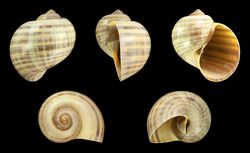Biology:Pomacea paludosa
| Pomacea paludosa Temporal range: Pliocene-present
| |
|---|---|

| |
| Colored engraving of a live Pomacea paludosa made by Helen Lawson († 1854) and published in 1845 A monograph of the freshwater univalve Mollusca of the United States: including notices of species in other parts of North America by Samuel Stehman Haldeman. | |
| Scientific classification | |
| Kingdom: | |
| Phylum: | |
| Class: | |
| (unranked): | |
| Superfamily: | |
| Family: | |
| Genus: | |
| Subgenus: | Pomacea
|
| Species: | P. paludosa
|
| Binomial name | |
| Pomacea paludosa (Say, 1829)
| |
| Synonyms[2] | |
| |
Pomacea paludosa, common name the Florida applesnail, is a species of freshwater snail with an operculum, an aquatic gastropod mollusk in the family Ampullariidae, the apple snails.
Shell description
This species is the largest freshwater gastropod native to North America.[3]
The shell is globose in shape. The whorls are wide, the spire is depressed, and the aperture is narrowly oval.[3] The shells are brown in color, and have a pattern of stripes.
The shell is 60 millimetres (2.4 in) in both length and width.[3]
Distribution
The indigenous distribution of this snail is central and southern Florida,[4] Cuba and Hispaniola.[5]
The nonindigenous distribution includes northern Florida. The species has also been found in Georgia, Oahu, Hawaii (Devick 1991)[citation needed], Louisiana, and Oklahoma.[5]
Ecology
This is a tropical species. It is amphibious, and can survive in water bodies that dry out during the dry season.[3]
Applesnails have both gills and lungs.
References
- ↑ Cordeiro, J.; Perez, K. (2011). "Pomacea paludosa". IUCN Red List of Threatened Species (IUCN) 2011: e.T189339A8718219. doi:10.2305/IUCN.UK.2011-2.RLTS.T189339A8718219.en. https://www.iucnredlist.org/species/189339/8718219. Retrieved 21 July 2022.
- ↑ ((MolluscaBase eds.)). "Pomacea paludosa (Say, 1829)" (in en). MolluscaBase. https://www.molluscabase.org/aphia.php?p=taxdetails&id=741885.
- ↑ 3.0 3.1 3.2 3.3 Burch, J. B. 1982. North American freshwater snails. Walkerana 1(4):217-365.
- ↑ Thompson, F.G. 1984. The freshwater snails of Florida: a manual for identification. University of Florida Press, Gainesville, Florida, 94 pp.
- ↑ 5.0 5.1 Dundee, D. S. 1974. Catalog of introduced molluscs of eastern North America (north of Mexico). Sterkiana 55:1-37.
- Applesnails of Florida Pomacea spp. (Gastropoda: Ampullariidae) <https://www.egovlink.com/public_documents300/winterhaven/published_documents/Winter%20Haven/Lakes/Backyard%20Wildlife/Animal%20Information/Snails%20and%20Slugs/Applesnails%20of%20Florida%20IN59800.pdf>
This article incorporates public domain text from:
- A. Benson. 2008. Pomacea paludosa. USGS Nonindigenous Aquatic Species Database, Gainesville, FL. <https://nas.er.usgs.gov/queries/FactSheet.asp?speciesID=985> Revision Date: 4/24/2006
Further reading
- McClary, A. 1962. Surface inspiration and ciliary feeding in Pomacea paludosa (Prosobranchia: Mesogastropoda: Ampullariidae). Malacologia, 2(1): 87-104.
- Philip C. Darby, Robert E. Bennetts, Jason D. Croop, Patricia L. Valentine-Darby and Wiley M. Kitchens A Comparison of Sampling Techniques for Quantifying Abundance of the Florida Apple Snail (Pomacea Paludosa Say). J. Moll. Stud. (1999), 65, 195-208.
- Philip C. Darby, Patricia L. Valentine-Darby, H. Franklin Percival & Wiley M. Kitchens. Collecting Florida applesnails (Pomacea paludosa) from wetland habitats using funnel traps. Wetlands. Volume 21, Issue 2 (June 2001): 308–311.
- Robert B.E. Shuford III, Paul V. McCormick & Jennifer Magson. Habitat related growth of juvenile Florida applesnails (Pomacea paludosa). Florida Scientist. Volume 68, Issue 1 (March 2005): 11–19.
- Bruce Sharfstein & Alan D. Steinman. Growth and survival of the Florida apple snail (Pomacea paludosa) fed 3 naturally occurring macrophyte assemblages. Journal of the North American Benthological Society, Volume 20, Issue 1 (March 2001): 84–95.
- Posch H., Garr A. L. & Reynolds E. (2013). "The presence of an exotic snail, Pomacea maculata, inhibits growth of juvenile Florida apple snails, Pomacea paludosa". Journal of Molluscan Studies 79(4): 383-385. doi:10.1093/mollus/eyt034.
- Applesnails of Florida on the UF / IFAS Featured Creatures Web site
- The applesnails of Florida
- Apple Snail Habitat Suitability Index
- https://web.archive.org/web/20060923125401/http://nis.gsmfc.org/nis_factsheet.php?toc_id=155
- http://www.applesnail.net/content/species/pomacea_paludosa.htm
Wikidata ☰ Q3142468 entry
 |




